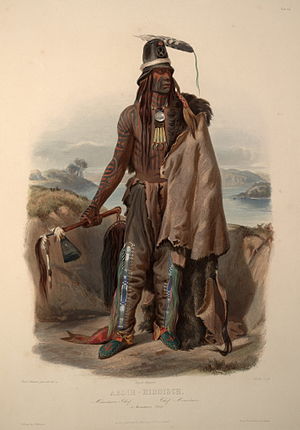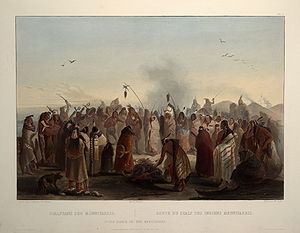- Hidatsa people
-
 Addih-Hiddisch, a Minitaree chief. Engraving after a watercolour by Karl Bodmer.
Addih-Hiddisch, a Minitaree chief. Engraving after a watercolour by Karl Bodmer.
The Hidatsa (called Minnetaree by their allies, the Mandan) are a Siouan people, a part of the Three Affiliated Tribes. The Hidatsa's autonym is Hiraacá. According to the tribal tradition, the word hiraacá derives from the word "willow"; however, the etymology is not transparent and the similarity to mirahací ‘willows’ inconclusive. The present name Hidatsa was formerly borne by one of the three tribal villages. When the villages consolidated, the name was adopted for the tribe as a whole. Their language is related to that of the Crow, and they are sometimes considered a parent tribe to the modern Crow in Montana. Occasionally they have also been confused with the Gros Ventres in Montana.
Accounts of recorded history in the early 18th century identify three closely related village groups to which the term Hidatsa is applied. What is now known as the Hidatsa tribe is the amalgamation of these three groups: the Hidatsa proper, the Awatixa, and the Awaxawi (or Amahami) (Bowers 1965). These groups had discrete histories and spoke different dialects; they came together only after settling on the Missouri River.
The Amahami have a creation tradition similar to that of the Mandan, which describes their emergence long ago from the Earth, at Devil's Lake. Later they moved westward to the Painted Woods (near Square Buttes) and settled near a village of Mandan and another of Awatixa.
The Awatixa originated not from the earth, but from the sky, led by Charred Body (Wood and Hanson 1986:34). According to their tradition, their first people lived near Painted Woods, "where they were created" (Bowers 1948:17-18). After that they always lived between the Heart and Knife Rivers along the Missouri.
The Hidatsa proper, largest of the three, were initially part of those who would become the River Crow. They separated from the Amahami in what is now western Minnesota. First they settled to the north, then later moved south to Devil's Lake. In their travels they met the Mandans and then moved westward and settled with these distant relatives north of the Knife River. Later they moved to the mouth of Knife River.
The Hidatsa originally lived in Miniwakan, the Devil's Lake region of North Dakota, before being pushed southwestward by the Lakota. As they migrated west, the Hidatsa came across the Mandan at the mouth of the Heart River. The two groups formed an alliance, and settled into an amiable division of territory along the area's rivers.
In 1804, Lewis and Clark came to the Hidatsa in three villages at the mouth of the Knife River, and the Mandan in two villages a few miles lower down on the Missouri River. Tribal appearance and customs have been documented by the visits of two artists of the American west. The allied tribes were first visited by American George Catlin, who remained with them several months in 1832. He was followed by Karl Bodmer, a Swiss painter accompanying German explorer Maximilian zu Wied-Neuwied on a Missouri River expedition from 1832 to 1834. Catlin and Bodmer's works record the Hidatsa and Mandan societies, where were rapidly changing under pressure from encroaching settlers, infectious disease, and government restraints.
The smallpox epidemic of 1837-1838 reduced the Hidatsa to about 500 people. The remaining Mandan and Hidatsa united, and moved farther up the Missouri in 1845. They eventually settled at "Like-a-fishhook" bend near Fort Berthold. They were joined there by the Arikara in 1862.
The Hidatsa are a matrilineal people, with descent determined through the maternal line. As the early Mandan and Hidatsa heavily intermarried, children were taught to speak the language of their mother, but understand the dialect of either tribe. A short description of Hidatsa-Mandan culture, including a grammar and vocabulary of the Hidatsa language, was published in 1877 by Washington Matthews, a government physician assigned to the Fort Berthold Indian Reservation.
During the early twentieth century, Gilbert Livingston Wilson carried out extensive ethnographic work with the elderly Hidatsa woman, Buffalo Bird Woman. He also interviewed members of her immediate family at Fort Berthold. From his information gathered from them, Wilson described traditional economy, ceremony, and day-to-day practices as remembered by Buffalo-Bird Woman, who lived at Like-a-Fishhook Village.
See also
- Historians Gerald W. Wolff and Joseph H. Cash collaborated on studies of six tribes, the Hidatsa, the Arikaras, the Mandans, the Poncas, the Ottawas, and the Comanche of Texas.
- Knife River Indian Villages National Historic Site
- Knife River: Early Village Life on the Plains, a National Park Service Teaching with Historic Places (TwHP) lesson plan
- Buffalo Bird Woman's Garden, As Recounted by Maxi'diwiac (Buffalo Bird Woman) (ca.1839-1932) of the Hidatsa Indian Tribe, Originally published as Agriculture of the Hidatsa Indians: An Indian Interpretation, by Gilbert Livingstone Wilson
- Minnesota State Historical Society Inventory of G.L. and F.N. Wilson’s Papers
- White Buffalo Cow Society
External links
- Mandan, Hidatsa, and Arikara Nation, official website
Categories:- Siouan peoples
- Plains tribes
- Native American tribes in North Dakota
- Native American history of North Dakota
Wikimedia Foundation. 2010.

